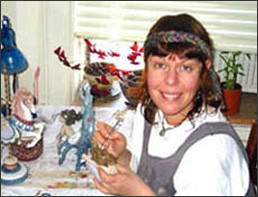According to scholarly research of the past 100 years, the invention of European porcelain is attributed to Johann Friedrich Bottger (1682-1719); however, modern independent researchers argue that it is Ehrenfried Walther von Tschirnhaus (1651-1708) who is the real inventor of porcelain in Europe.
The well-known story is that Tschirnhaus, who was Bottger’s supervisor, failed to discover the much coveted “porcelain formula” during his lifetime. After his death, his protégé J.F. Bottger managed to discover arcanum. Did he do it independently of Tschirnhaus’s research or was he standing on the shoulders of a giant? Probably the latter.
At a Majolica Conference in early August of 2012, Luba Sokolina, a porcelain restoration expert from New York City, spoke with Lena Steiner, a ceramicist and china restoration authority from Vienna, Austria regarding Tschirnhaus’s contribution to the “European porcelain discovery”. Below is a part of their recorded conversation:
L. Sokolina:
Do you think that Tschirnhaus deservers more credit than he’s given by the historians and scholars? After all, he studied medicine, science, published academic papers, and had very wide-ranging interests. I read somewhere that he was a close friend of Spinoza’s and even published a philosophical treatise in a respected journal. While Bottger had no prior experience in research at all when he became Tschirnhaus’s laboratory assistant.
L. Steiner:
Bottger was an alchemist, a con man. He claimed to know how to make gold, for which he ended up serving a prison sentence. He assisted Tschirnhaus in the lab for many years, until Tschinhaus’s death. Immediately after… well, several months later… Bottger announced that he discovered the formula for porcelain. Shortly after he was appointed Supervisor of the newly formed Meissen factory. I believe the year was around 1710. He held the position until his death.
L. Sokolina:
So it was a group effort, something that took years. Like with pretty much everything else, the Eureka moment is a myth. It’s usually a lot of hard, tedious work involving more than one person.
L. Steiner:
I know it’s popular in America now to believe that everything is a group effort and nothing comes from a single individual talent. I’ve read the book by the New Yorker writer… what’s his name…?
L. Sokolina:
Malcolm Gladwell. Outliers.
L. Steiner:
Yes. Well, in the case of Bottger and Tschirnhaus I believe that happens to be true. Tschrinhaus set the stage for porcelain restoration and did the hard work; Bottger helped and took the credit.
What is Porcelain?
Porcelain evolved from stoneware, a brittle ceramic made of clay and fired at about 1,250°C. Around the 9th century, Chinese clay arBetween the seventh and tenth centuries, Chinese artisans replaced the clay in stoneware with a mixture of kaolin, quartz, and feldspar, and fired this concoction at a temperature of about 1,320°C.
What distinguished porcelain from stoneware was mainly the coarseness of the material. Stoneware clay consists of coarse silicates of aluminum, while porcelain is a fine-grained white clay that stays white when fired (stoneware clay changes color under high temperatures). Porcelain is much more lithe, strong and water resistant than stoneware. When tapped, it makes a clear ring (stoneware makes a muffled sound).
The European approach to porcelain making was firing it at higher temperatures and adding more kaolin, which resulted in hard-paste porcelain as opposed to soft-paced invented and perfected by the Chinese.
The Meissen factory, with Bottger in charge, became the first and only (at that time) European maker of real (true) porcelain outside of China. While Bottger became rich and famous, Tschirnhaus’s work has been largely forgotten.
Contact the Porcelain Repair experts for all your china restoration needs.
www.luelstudio.com
email: luba@luelstudio.com
646-251-5593


Speak Your Mind